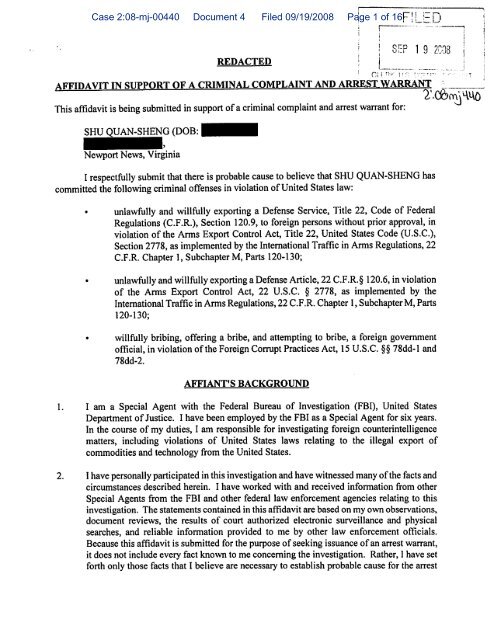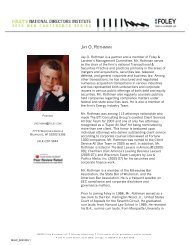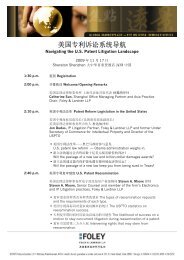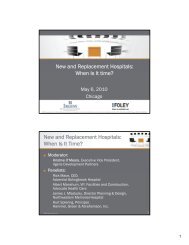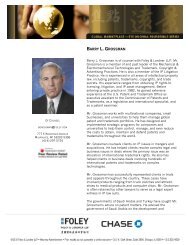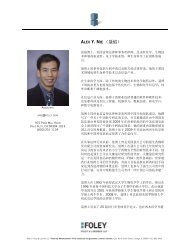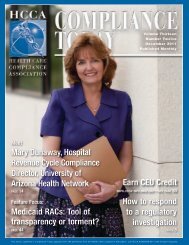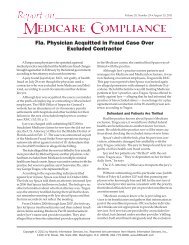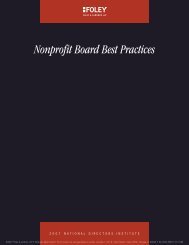View Affidavit
View Affidavit
View Affidavit
You also want an ePaper? Increase the reach of your titles
YUMPU automatically turns print PDFs into web optimized ePapers that Google loves.
Case 2:08-mj-00440 Document 4 Filed 09/19/2008 Page 1 of 16F!L£D_<br />
REDACTED<br />
| gpp i g opg<br />
AFFIDAVIT IN SUPPORT OF A CRIMINAL COMPLAINT AND ARREST WARRANT<br />
This affidavit is being submitted in support of a criminal complaint and arrest warrant for:<br />
SHUQUANJ3HENG (DOB:<br />
Newport News, Virginia<br />
I respectfully submit that there is probable cause to believe that SHU QUAN-SHENG has<br />
committed the following criminal offenses in violation of United States law:<br />
unlawfully and willfully exporting a Defense Service, Title 22, Code of Federal<br />
Regulations (C.F.R.), Section 120.9, to foreign persons without prior approval, in<br />
violation of the Arms Export Control Act, Title 22, United States Code (U.S.C),<br />
Section 2778, as implemented by the International Traffic in Arms Regulations, 22<br />
C.F.R. Chapter 1, SubchapterM, Parts 120-130;<br />
unlawfully and willfully exporting a Defense Article, 22 C.F.R.§ 120.6, in violation<br />
of the Arms Export Control Act, 22 U.S.C. § 2778, as implemented by the<br />
International Traffic in Arms Regulations, 22 C.F.R. Chapter 1, Subchapter M, Parts<br />
120-130;<br />
• willfully bribing, offering a bribe, and attempting to bribe, a foreign government<br />
official, in violation of the Foreign Corrupt Practices Act, 15 U.S.C. §§ 78dd-l and<br />
78dd-2.<br />
AFFIANT'S BACKGROUND<br />
1. I am a Special Agent with the Federal Bureau of Investigation (FBI), United States<br />
Department of Justice. I have been employed by the FBI as a Special Agent for six years.<br />
In the course of my duties, I am responsible for investigating foreign counterintelligence<br />
matters, including violations of United States laws relating to the illegal export of<br />
commodities and technology from the United States.<br />
2. I have personally participated in this investigation and have witnessed many of the facts and<br />
circumstances described herein. I have worked with and received information from other<br />
Special Agents from the FBI and other federal law enforcement agencies relating to this<br />
investigation. The statements contained in this affidavit are based on my own observations,<br />
document reviews, the results of court authorized electronic surveillance and physical<br />
searches, and reliable information provided to me by other law enforcement officials.<br />
Because this affidavit is submitted for the purpose of seeking issuance of an arrest warrant,<br />
it does not include every fact known to me concerning the investigation. Rather, I have set<br />
forth only those facts that I believe are necessary to establish probable cause for the arrest
Case 2:08-mj-00440 Document 4 Filed 09/19/2008 Page 2 of 16<br />
warrant sought herein. Where the content of documents and the actions, conversations and<br />
statements of others are set forth herein, they are related in substance and in part only. Most<br />
of the conversations recounted in this affidavit were originally in Mandarin Chinese. The<br />
conversations have been transcribed by certified interpreters, whom I believe to be truthful<br />
and reliable.<br />
3. The evidence gathered in furtherance of this investigation has included the following<br />
investigative techniques: trash cover; interviews; issuance of National Security Letters;<br />
issuance of Grand Jury Subpoenas; physical surveillance; and court authorized electronic<br />
surveillance and physical searches.<br />
EXPORT LAWS AND REGULATIONS<br />
4. The Arms Export Control Act, 22 U.S.C. § 2778, requires a person or company to obtain a<br />
valid export license from the Directorate of Defense Trade Controls of the United States<br />
Department of State before exporting defense articles and services from the United States.<br />
5. The Arms Export Control Act is implemented by a set of regulations known as the<br />
International Traffic in Arms Regulations, which are set out in 22 C.F.R. Parts 120 - 130.<br />
Part 120 of the International Traffic in Arms Regulations sets forth the purpose and<br />
background of the regulations and provides definitions for the terms used; Part 121 contains<br />
the United States Munitions List which enumerates, by category, the defense articles and<br />
services subject to export controls; Part 122 sets forth the registration requirements for those<br />
engaged in the business of manufacturing or exporting defense articles and services; Parts<br />
123, 124, and 125 outline the license requirements for Munitions List items; Part 126<br />
contains general policy provisions; and Part 127 sets forth prohibited activities and the<br />
applicable penalties.<br />
6. In an application for an export license, an exporter is required to state, among other things,<br />
the nature of the defense articles and services to be exported, the end recipient of the defense<br />
articles and services, and the purpose for which the defense articles and services are intended.<br />
These factors and others assist the Directorate of Defense Trade Controls in determining<br />
whether the export of the defense articles or services would further the security and foreign<br />
policy interests of the United States.<br />
7. Under 22 C.F.R. § 120.17(a), the term "export" is defined, in relevant part, as:<br />
(I) Sending or taking a defense article out of the United States in any manner, except by<br />
mere travel outside of the United States by a person whose personal knowledge<br />
includes technical data; or<br />
(4) Disclosing (including oral or visual disclosure) or transferring technical data to a<br />
foreign person, whether in the United States or abroad; or
Case 2:08-mj-00440 Document 4 Filed 09/19/2008 Page 3 of 16<br />
(5) Performing a defense service on behalf of, of for the benefit of, a foreign person,<br />
whether in the United States or abroad.<br />
8. Under 22 C.F.R. § 120.9, a defense service is defined as:<br />
(a) Defense service means:<br />
(1) The furnishing of assistance (including training) to foreign persons, whether<br />
in the United States or abroad in the design, development, engineering,<br />
manufacture, production, assembly, testing, repair, maintenance,<br />
modification, operation, demilitarization, destruction, processing or use of<br />
defense articles;<br />
(2) The furnishing to foreign persons of any technical data controlled under this<br />
subchapter... whether in the United States or abroad; or<br />
(3) Military training of foreign units and forces, regular and irregular, including<br />
formal or informal instruction of foreign persons in the United States or<br />
abroad or by correspondence courses, technical, educational, or information<br />
publications and media of all kinds, training aid, orientation, training<br />
exercise, and military advice.<br />
9. Only "United States Persons" are eligible to provide defense services under the International<br />
Traffic in Arms Regulations. The term "United States Person" is defined in 22 C.F.R.<br />
§ 120.15, and includes U.S. citizens and other entities incorporated in the United States.<br />
10. A United States person seeking to provide defense services is required to submit for approval<br />
by the Directorate of Defense Trade Controls a proposed agreement with the foreign person<br />
to receive the services, known as a Technical Assistance Agreement (TAA). All TAA<br />
submissions must specifically describe the defense services being provided.<br />
11. The defense services described in the TAA are prohibited from being provided to the foreign<br />
person or persons unless and until a license has been approved and issued by the Directorate<br />
of Defense Trade Controls. The Directorate of Defense Trade Controls may approve or<br />
reject the defense services described in the TAA in whole or in part.<br />
12. At no time did defendant SHU QUAN-SHENG receive or possess a license to export defense<br />
services to a foreign person.<br />
FOREIGN CORRUPT PRACTICES ACT<br />
13. Congress enacted the Foreign Corrupt Practices Act of 1977 (FCP A), as amended, 15 U.S.C.<br />
§§ 78dd-l, et seq., for the purpose of, among other things, prohibiting United States persons,
usinesses and residents, directly or indirectly, from using any means or instrumentality of<br />
interstate or foreign commerce, including the United States mails, in furtherance of an offer,<br />
promise, authorization or payment of money or anything else of value to a foreign<br />
government official, political party or political party official to assist in obtaining or retaining<br />
business for or with, or directing business to, any person.<br />
14. Specifically, 15 U.S.C. § 78dd-l prohibits any issuer, as well as any officer, director,<br />
employee or agent of such issuer, from willfully making use of the mails or any means or<br />
instrumentality of interstate or foreign commerce, including the United States mails,<br />
corruptly in furtherance of an offer, promise, authorization, or payment of money or anything<br />
else of value to a foreign official for the purpose of obtaining or retaining business for, or<br />
directing business to, any person.<br />
15. Title 15, U.S.C. § 78dd-2 similarly prohibits any "domestic concern," including any U.S.<br />
citizen, resident, or corporation with its principal place of business in the United States, or<br />
which is organized under the laws of a State of the United States, from engaging in such<br />
Background<br />
Case 2:08-mj-00440 Document 4 Filed 09/19/2008 Page 4 of 16<br />
corrupt conduct.<br />
FACTS SUPPORTING PROBABLE CAUSE<br />
16. SHU QUAN-SHENG (hereimfigrJjSHlIljl is a citizen and resident of the United States,<br />
born in Shanghai, China on^^^^BI SHU received his bachelor's degree from the<br />
China University of Science and Technology, Beijing, China, in July, 1963, and earned his<br />
PhD in Physics from the Institute of Low Temperature, Hangzou, China, in September, 1970.<br />
SHU remained at the Institute of Low Temperature until September 1977 when he became<br />
an Associate Professor of Physics at Zhejiang University, Hangzhou, China and remained<br />
in that position until February 1983. In 1985, SHU obtained a full professorship at Zhejiang<br />
University while working at the U.S. Department of Energy's Fermi National Accelerator<br />
Laboratory.<br />
17. SHU first entered the United States in March of 1983 to conduct research in ultra-low<br />
temperature physics at the University of Washington, Seattle, Washington. SHU became a<br />
naturalized U.S. citizen on May 13,1998 and incorporated AMAC INTERNATIONAL, INC.<br />
(AMAC) in the Commonwealth of Virginia on October 14,1998. SHU currently serves as<br />
the President, Secretary and Treasurer of AMAC.<br />
18. AMAC is a high tech company that performs research through grants funded by the Small<br />
Business Innovative Research program on behalf of the Department of Energy, and the<br />
National Aeronautics and Space Administration (NASA). AMAC is located at the Applied<br />
Research Center on the grounds of the Department of Energy's Thomas Jefferson National<br />
Accelerator Facility in Newport News, Virginia. AMAC also has an office location in
Case 2:08-mj-00440 Document 4 Filed 09/19/2008 Page 5 of 16<br />
Beijing, People's Republic of China (PRC). Through one research grant in particular,<br />
AMAC developed cryogenic transfer and storage technology for liquid propellants used in<br />
aerospace applications. In that instance, AMAC developed an energy efficient cryogenic<br />
transfer line with magnetic suspension for NASA's Kennedy Space Center offering a<br />
potential advantage of extending space missions, saving cryogenic fuel, and reducing overall<br />
launch mass.<br />
19. Through its branch office in Beijing, AMAC facilitates transactions between U.S. and<br />
European technology companies as sellers and government entities in the PRC as buyers.<br />
These technology companies specialize in cryogenic systems, including hydrogen and helium<br />
liquefiers, equipped tanks, pumps, valves, and transfer lines, as well as power amplifiers,<br />
precision measurement equipment, vacuum and flow instrumentation, gas detection, and<br />
advanced telecommunications products.<br />
20. A French Company, hereinafter referred to as French Company A, supplies industrial gases<br />
and related services to a variety of industries, including aerospace. French Company A is<br />
headquartered in Paris, France, with operations in more than 70 countries including<br />
significant operations in the United States. French Company A's stock trades on the Paris<br />
stock exchange (Euronext). French Company A's American Depositary Receipts are<br />
registered with the Securities and Exchange Commission (SEC) pursuant to 15 U.S.C. §<br />
78(g) and traded on the over the counter exchange. Accordingly, French Company A was<br />
an issuer as that term is used in the FCPA. A specific division of French Company A,<br />
identified as French Company Division I, develops and maintains ultra-low temperature<br />
products and services for aeronautical applications.<br />
21. SHU and AMAC entered into a written agency agreement dated December 1, 2003, with<br />
French Company Division I to be the division's sole representative in the PRC. In that role,<br />
as outlined below, SHU is tasked by PRC government entities to facilitate the procurement<br />
effort, provide technical expertise, and negotiate price and contract terms.<br />
SUMMARY OF INVESTIGATION<br />
Assistance to Foreign Persons in the Development of a Launch Facility<br />
22. Beginning in or around January of 2003, SHU provided technical assistance and foreign<br />
technology acquisition expertise to several PRC government entities involved in the design,<br />
development, engineering and manufacture of a space launch facility in the southern island<br />
province of Hainan, PRC. This facility will house liquid-propelled heavy payload launch<br />
vehicles designed to send space stations and satellites into orbit, as well as provide support<br />
for manned space flight and future lunar missions.<br />
23. SHU is an expert in cryogenics and has provided technical assistance, as well as foreign<br />
technology acquisition of equipment and technologies relating to production, transfer and
Case 2:08-mj-00440 Document 4 Filed 09/19/2008 Page 6 of 16<br />
storage of liquefied hydrogen. Liquefied hydrogen will be used as the propellant for the<br />
heavy payload launch vehicles at the Hainan launch facility.<br />
24. Several PRC government entities are involved in the space launch facility project, including<br />
the People's Liberation Army's General Armaments Department and the 101st Research<br />
Institute (101 Institute), which is one of many research institutes that make up the China<br />
Academy of Launch Vehicle Technology, as overseen by the Commission of Science<br />
Technology and Industry for the National Defense. The Beijing Special Engineering Design<br />
Research Institute (BSEDRI) is the governmental entity responsible for the procurement of<br />
cryogenic liquid storage tanks for the Hainan launch facility.<br />
25. The 101 Institute is located in the Changxindian area of Beijing and is the final assembly and<br />
testing location for liquid rocket engines. In addition to testing rocket propulsion systems,<br />
the 101 Institute is involved in developing rocket ground support equipment technology,<br />
cryogenic technology, automation control and automated testing technology, chemical<br />
technology and environmental protection technology, along with numerous commercial<br />
products also associated with integrated space testing and research activities.<br />
26. The People's Liberation Army's General Armaments Department has planned and<br />
implemented a phased approach to the Hainan launch facility project. In conjunction with<br />
the construction of the launch facility in Hainan, the 101 Institute will use its production and<br />
testing facility in Beijing to study the capabilities of hydrogen propelled engines and ground<br />
support equipment, including the equipment designed, manufactured, and procured by SHU<br />
and AMAC.<br />
27. SHU has been involved in the PRC's systematic effort to upgrade their space exploration and<br />
satellite technology capabilities by providing technical expertise and foreign technology<br />
acquisition in the fields of cryogenic pumps, valves, transfer lines and refrigeration<br />
equipment, components critical for the use of liquefied hydrogen in a launch facility. SHU<br />
has also been instrumental in arranging for PRC officials to visit various European space<br />
launch facilities and hydrogen production/storage facilities.<br />
28. SHU's efforts include the successful brokering of a January, 2007 contract between the 101<br />
Institute and French Company A for the production and supply of a 600 liter per hour<br />
hydrogen liquefier. This liquefier will be part of the 101 Institute's comprehensive research,<br />
development, and test base for liquid-propelled engines and space vehicle components, and<br />
at the time, the liquefier represented the first in as many as five additional projects to be<br />
undertaken by AMAC and French Company A, all to be used as ground based support for<br />
the launch vehicles at the Hainan launch facility.<br />
29. The People's Liberation Army's General Armaments Department has expressed interest in<br />
producing liquefied hydrogen at a gas-to-liquid conversion rate of up to 4000 liters per hour<br />
for use in a large scale launch vehicle. AMAC and SHU have expended enormous amounts
Case 2:08-mj-00440 Document 4 Filed 09/19/2008 Page 7 of 16<br />
of time and resources on the procurement effort for small capacity equipment for research<br />
and development purposes in anticipation of a larger effort to meet the PRC's extraordinary<br />
need for converted fuel for the Hainan launch facility.<br />
30. The culmination of efforts undertaken by SHU and AM AC on behalf of the PRC will result<br />
in the new Hainan launch facility having capabilities at least as advanced, if not more<br />
advanced than, as the Ariane-5 Launch Site at the European Space Agency's Guiana Space<br />
Center, Kourou, French Guiana, the benchmark facility after which the Hainan launch facility<br />
is being modeled.<br />
Launch Vehicle Fuel Storage Tanks and Associated Equipment<br />
31. On January 17, 2003, SHU traveled from Norfolk, Virginia to the PRC. A compact disc<br />
discovered during a court authorized search was labeled, "Dr. Shu Travel to China,<br />
01/16/2003, AMAC." The compact disk contained a Microsoft Power Point Presentation<br />
(presentation) dated January 18, 2003. The presentation, entitled, "Liquid LH & LOX<br />
Technologies - Storage and Transfer in Large Scale," contained several pictures of launch<br />
facilities, and included multiple references to liquid hydrogen (LH) and liquid oxygen (LOX)<br />
applications in launch vehicle technology. The presentation also contained specific technical<br />
information on LH and LOX tanks, as well as information on cryogenic pumps, cryogenic<br />
valves, high vacuum cryostats, and temperature and liquid level sensors.<br />
32. On July 31,2003, SHU traveled to the PRC again to discuss a cooperation proposal between<br />
AMAC and the BSEDRI. A "Proposal for Intended Cooperation," prepared by BSEDRI and<br />
dated August 14,2003, outlined BSEDRI's requirements for "the design and manufacture of<br />
the large-scale liquid hydrogen storage container," specifically sought AMAC's technological<br />
cooperation, and invited AMAC to preside over the proof plan and perform technological<br />
design work for this project.<br />
33. In November of 2003, the BSEDRI formally invited AMAC to "attend the bidding session<br />
concerning the first phase product manufacturing and testing for the storage tank system of<br />
liquid hydrogen and liquid oxygen," for the Hainan Launch Facility, along with air and<br />
manual operation thermal insulating valves and filters.<br />
34. On December 1, 2003, SHU contacted a representative of French Company A, referred to<br />
herein as Representative A, via e-mail to notify the company of the PRC's interest in<br />
obtaining the design specifications on a 100 cubic meter liquid hydrogen mobile storage tank<br />
and the design specifications on a 30 cubic meter liquid oxygen storage tank, complete with<br />
specifications on cryogenic valves, testing facilities and test procedures. In the same e-mail,<br />
SHU warned Representative A that, with this level of technical detail, the PRC could use the<br />
design specifics to fabricate the items inside the PRC.<br />
35. On December 17,2003, SHU contacted French Company A representatives, Representative<br />
A and another representative employed by French Company A, referred to herein as
Case 2:08-mj-00440 Document 4 Filed 09/19/2008 Page 8 of 16<br />
Representative B, via fax and explained that they had until December 20,2003 to submit<br />
their proposal for the PRC's liquid hydrogen system, and that the PRC officials needed<br />
general design information with pictures and plots for the two tanks as well as a vaporization<br />
system for transferring liquid hydrogen at a rate of five thousand liters per minute. At that<br />
time, SHU stated the three phases of this project were worth more than $20 million, and to<br />
win some of phase one, the proposal needed to contain specific technical information.<br />
36. On December 20, 2003, SHU submitted to the BSEDRI a package of information entitled<br />
"Commercial Information, Technical Proposal & Budgetary Offer - Design, Supply,<br />
Engineering, Fabrication, Testing & Commissioning of 100m3 Liquid Hydrogen Tank and<br />
Various Special Cryogenic Pumps, Valves, Filters & Instruments." The package of<br />
documents, numbering approximately 50 pages, contained technical design drawings of the<br />
tanks, as provided by French Company A, along with other technical information relating to<br />
their performance, testing, and use. The package also contained a quotation for a 100 cubic<br />
meter liquid hydrogen tank and other cryogenic components.<br />
37. On February 20,2004, AMAC employees met in Beijing with a foreign government official<br />
from the BSEDRI (PRC Official A), and several other engineers to discuss technological<br />
requirements for the liquid hydrogen storage tank project.<br />
38. An internal AMAC report, drafted after the February 20, 2004 meeting, entitled "Status<br />
Report to Project '110m3 LH2 Tank,"' indicates that, if funded, the "project" would facilitate<br />
the purchase of a liquid hydrogen tank in 2005. The document states that the information<br />
was provided by "Dr. [PRC Official A]" from the BSEDRI. The document also gives a<br />
tentative time line for the tank project, and includes hand-written references to similar steps<br />
taken for the liquefier, valves, and pumps. According to the document, for the purchasing<br />
of large equipment, PRC Official A suggests technical cooperation between three parties:<br />
(a) the BSEDRI; (b) AMAC and French Company A; and (c) one "war industry company"<br />
in the PRC.<br />
39. On July 6, 2004, AMAC U.S. Employee A sent an e-mail to Representative B informing<br />
Representative B that the BSEDRI notified AMAC that the Institute had a new plan to<br />
produce two 50 cubic meter tanks, three 330 cubic meter tanks, and one 1200 cubic meter<br />
tank.<br />
40. On July 7,2004, Representative B responded to AMAC U.S. Employee A's e-mail, stating<br />
that French Company A sold two 360 cubic meter semi mobile tanks to the Kourou site in<br />
1990 and 2002 respectively. Representative B indicated that a tank of this grade and capacity<br />
could meet the request.<br />
41. On February 23,2005, the BSEDRI submitted to AMAC a document entitled "Require [sic]<br />
Quotation about LH2 Tanks for Hydrogen Liquefied Equipment." This document states,<br />
"Our institute would like to use a 320 m3 moving tank (the references are same to the
Case 2:08-mj-00440 Document 4 Filed 09/19/2008 Page 9 of 16<br />
Ariane 5's) as the LH2 receiving Tanks. Please give us the quotation for the following two<br />
kinds: 1) LH2 tank which can be moved with LH2; 2) LH2 Tank which can only be moved<br />
emptily."<br />
42. On February 24,2005, AMAC submitted a Required Quotation, numbered 0502 AL SEDI<br />
801, to French Company A for one 320 cubic meter liquid hydrogen storage tank with<br />
specifications resembling the tank at the Kourou launch facility.<br />
43. On March 9, 2005, French Company A submitted to AMAC a document entitled,<br />
"COMMERCIAL AND TECHNICAL INFORMATION" addressed to the BSEDRI. Under<br />
the heading, "Purpose of the 360 M3 LH2 Standard Tank," the document states, "This<br />
proposal is [French Company A] 's answers to BSEDRI China concerning the design, supply,<br />
engineering, fabrication, testing, and commission of a 360 m3 Liquid Hydrogen Tank." The<br />
document states that "the scope of [French Company Division I] is based on similar tank<br />
already manufactured for European Space Launch Pad in French Guyana whose drawings<br />
are attached in annex."<br />
44. On December 19,2005, SHU and AMAC U.S. Employee A participated in a conference call<br />
to Representative A regarding the final budget proposal for the 101 Institute. During that<br />
phone conference, SHU stated to Representative A that the current liquefaction project is<br />
related to the "Special Design and Research Group" storage tank project which will be<br />
delayed approximately eighteen months. SHU also stated that this project is directly related<br />
to manned space flight, and, if this smaller project is won, so too will a larger project.<br />
45. From approximately December 2005 until January 2007, SHU brokered a deal between the<br />
101 Institute and French Company Division I for the production and supply of one 600 liter<br />
per hour hydrogen liquefier. The 101 Institute is the final assembly and testing location for<br />
liquid rocket engines, and, as indicated in paragraph 41 above, this 600 liter per hour<br />
hydrogen liquefier project is directly related to the BSEDRI project at Hainan Island. SHU's<br />
efforts resulted in French Company Division I being awarded the contract, dated<br />
January 15, 2007, for which AMAC was to be paid a commission of 295,425 Euros<br />
(approximately $425,000 USD). On June 21,2007, AMAC received a wire transfer from<br />
French Company Division I in the amount of $ 131,283.14 USD, and on September 24,2007,<br />
AMAC received a second wire transfer from French Company Division I in the amount of<br />
$122,669.32 USD.<br />
46. On July 6, 2007, SHU placed a telephone call to AMAC Beijing Employee B to introduce<br />
her to the project. At that time, SHU stated to AMAC Beijing Employee B that this project<br />
involves a 360 cubic meter storage tank and a 3-4 cubic meter per hour (3000-4000 ltr/hr)<br />
hydrogen liquefier. AMAC Beijing Employee B asked SHU if Institute 408 was involved<br />
in the project, since Institute 408 deals in nitrogen liquefaction. SHU responded negatively<br />
stating that nitrogen liquefaction has nothing to do with hydrogen liquefaction. SHU stated,<br />
"The liquid hydrogen and liquid oxygen will burn... then the missile is launched. This.. .
Case 2:08-mj-00440 Document 4 Filed 09/19/2008 Page 10 of 16<br />
is for the Lunar Mission Launch Facility on Hainan Island. . . .For use ... in the largescale<br />
... lunar landing rockets' launch facility this project has been established for three<br />
years, that is, and we have followed it for three years."<br />
47. On August 18, 2007, SHU sent an e-mail to AMAC Beijing Employee B offering<br />
background information on the project, stating that "AMAC has followed this project for<br />
about 3 years and we have had many meetings with the Beijing Special Design and Research<br />
Institute and developed a working relationship with their engineering team of the project.<br />
We also meet their former directors and give our technical proposal and some estimation of<br />
the cost to them about one and a half years ago. We have arranged [French Company A]'s<br />
engineer to discuss with their technical leader. ... We understand the Institute leader and<br />
technical team has visited the European launch site in Central America Kourou, where the<br />
LH2 purifier and tank were made by [French Company A]. And they enjoy the high quality<br />
of these products. AMAC would like to make our contribution to this project."<br />
State Department License Determinations<br />
48. On December 3,2007, the Directorate of Defense Trade Controls, United States Department<br />
of State, issued a licensing determination certifying all of the following:<br />
a. The "Standard 100 M3 Liquid Hydrogen (LH) 2 Tank" described in the document<br />
entitled "Commercial Information, Technical Proposal & Budgetary Offer - Design,<br />
Supply, Engineering, Fabrication, Testing & Commissioning of 100m3 Liquid<br />
Hydrogen Tank and Various Special Cryogenic Pumps, Valves, Filters &<br />
Instruments" is a defense article covered by Category IV(h) on the United States<br />
Munitions List.<br />
b. The document entitled "Commercial Information, Technical Proposal & Budgetary<br />
Offer - Design, Supply, Engineering, Fabrication, Testing & Commissioning of<br />
100m3 Liquid Hydrogen Tank and Various Special Cryogenic Pumps, Valves, Filters<br />
& Instruments" contains technical data covered by Category IV(i) on the United<br />
States Munitions List.<br />
c. Negotiating or arranging a contract, purchase, sale or transfer of the "Standard 100<br />
M3 LH2 Tank," a defense article, to the "Heavy Payload Launch Facility" in the PRC<br />
in return for a fee, commission, or other consideration constitutes brokering activity<br />
as defined in Section 129.2 of the International Traffic in Arms Regulations.<br />
d. A proposal to sell or transfer a defense article to the PRC, a proscribed country under<br />
Section 126.1 (a) of the International Traffic in Arms Regulations, requires a license<br />
or written approval of the Directorate of Defense Trade Controls in accordance with<br />
Section 126.1 (e) of the International Traffic in Arms Regulations.<br />
10
Case 2:08-mj-00440 Document 4 Filed 09/19/2008 Page 11 of 16<br />
e. Providing assistance to foreign persons in the design, development, assembly,<br />
operation, testing or modification of the "Standard 100 M3 LH2 Tank," and related<br />
components of fueling systems for a foreign launch facility constitutes a defense<br />
service and is covered by Category IV(I) on the United States Munitions List.<br />
f. A proposal to sell or transfer a defense service to the PRC requires a license or<br />
written approval of the Directorate of Defense Trade Controls in accordance with<br />
Section 126.1(e) of the International Traffic in Arms Regulations.<br />
49. On September 5,2008, the Directorate of Defense Trade Controls, United States Department<br />
of State, issued a licensing determination certifying that the document entitled "Additional<br />
Technical Information of Design & Manufacture of a Mobile 100-m3 LH2 Tank" dated<br />
March 8,2004 (sections 3.1-8.6 and sections 13.2-13.5) contains technical data covered by<br />
Category IV(i) on the United States Munitions List.<br />
50. The United States maintains an arms embargo on the PRC, and, accordingly, it is the policy<br />
of the United States to deny licenses and other approvals for exports of defense articles and<br />
defense services destined for the PRC (22 C.F.R.§ 126.1 (a) & (e)).<br />
51. A registration and licensing search was conducted on SHU and AMAC. No record has been<br />
found of any registration application, application for an export license, or any other written<br />
approval granted to SHU and/or AMAC with respect to brokering, export of defense articles<br />
or proposals to provide defense services to the PRC.<br />
Evidence of SHU's Willfulness<br />
52. On or about February 3, 2005, SHU had a meeting in the PRC with officials from the<br />
Commission of Science Technology and Industry for the National Defense. In a subsequent<br />
e-mail sent on that same date to another representative of French Company A, referred to<br />
herein as Representative C, SHU summarized this meeting and detailed several points about<br />
the launch facility project. This e-mail goes on to state the group would like the launch base<br />
to be developed like Kennedy Space Center. SHU strongly encouraged the officials to visit<br />
French Company A and the launch facility in Kourou.<br />
53. On November 8, 2005, SHU and a number of other AMAC employees attended a meeting<br />
at the 101 Institute in Beijing. At this time, the leaders of the 101 Institute discussed the<br />
launch facility project, and stated specifically that they were interested in procuring a set of<br />
hydrogen liquefiers with an output of 600 liters per hour. On the same date, SHU and his<br />
wife discussed the project, and SHU specifically stated that the project is being overseen by<br />
the General Armaments Department, the acquisition arm of the People's Liberation Army.<br />
54. On November 30, 2005, SHU stated in a telephone conversation with AMAC Beijing<br />
Employee C, that SHU is well connected to senior leaders of the General Armaments<br />
11
Case 2:08-mj-00440 Document 4 Filed 09/19/2008 Page 12 of 16<br />
Department. During the same conversation, SHU requested that AMAC Beijing Employee<br />
C send all correspondence to SHU via fax instead of e-mail because SHU does not let his<br />
American employees know all the details regarding his business with the PRC military. SHU<br />
also criticized AMAC Beijing Employee C for revealing the true identity of a PRC end-user<br />
to AMAC U.S. Employee A, instructing AMAC Beijing Employee C that, in the future, the<br />
employee should make up an end-user when dealing with the PRC military because of U.S.<br />
restrictions on military technology being sent to the PRC.<br />
55. On December 13, 2005, SHU had a telephone conversation with PRC Official C, Deputy<br />
Chief of the 101 Institute, in which SHU informed the official that SHU would like to<br />
contact the official directly because SHU does not want AMAC employees in Beijing to<br />
know about certain unspecified matters. In response, PRC Official C provided SHU with his<br />
home telephone number so that SHU could contact him discreetly.<br />
56. In a February 3,2006, phone conversation, SHU stated to Representative A, referencing the<br />
101 Institute, "[w]e have to make deal with them [t]his is kind of a military company .<br />
.. for the rockets."<br />
57. On April 5, 2006, the 101 Institute Chief Engineer, PRC Official D, told SHU during a<br />
telephone conversation that representatives from French Company A should make a trip to<br />
Beijing as soon as possible to have final technology discussions with the 101 Institute. PRC<br />
Official D stated during that phone conversation that, if all goes well, the 101 Institute will<br />
sign an aeronautics cooperation agreement between the 101 Institute and French Company A.<br />
58. OnApril 10,2006, SHU stated in a telephone conversation with AMAC Beijing Employee C<br />
that the 101 Institute would not tell everything to [French Company A], which meant that<br />
some of the 101 Institute's real usage for the product which "involve the military aspect"<br />
would not be released to outsiders.<br />
59. On May 18,2006, SHU telephoned the Chief of the 101 Institute, PRC Official E, to invite<br />
him, along with other officials from the 101 Institute and the Commission of Science<br />
Technology and Industry for the National Defense (the "bureau" which oversees the 101<br />
Institute in general and this project in particular), to visit France and the launching factory<br />
in Kourou, French Guyana, because a great deal of the hydrogen equipment from French<br />
Company A applies to the rocket launching base.<br />
60. On May 31,2006, AMAC Beijing Employee C sent an e-mail to Representative C regarding<br />
the necessary invitation letter from French Company A to the leaders of the 101 Institute for<br />
the purpose of obtaining a visa to visit France. In this e-mail, AMAC Beijing Employee C<br />
stated that, "because of confidential request, 101 Institute can not appear in the letter. It will<br />
be replaced by China Great Wall Industry Corporation." On June 1, 2006, another<br />
representative of French Company A, Representative D, complied with the request and<br />
forwarded an invitation letter addressed to the China Great Wall Industry Corporation.<br />
12
Case 2:08-mj-00440 Document 4 Filed 09/19/2008 Page 13 of 16<br />
61. On June 24,2006, SHU stated to an unidentified female in the PRC that French Company<br />
A should be preferred over its competitor since the competitor's technology is adequate for<br />
hydrogen production for civilian use, but 95% of the low temperature products in Europe for<br />
rockets are produced by French Company A. SHU specifically stated that, "So this<br />
advantage is obvious... [French Company A's competitor] mainly is for civilian use while<br />
... Europe is for military use ... so it pretty much fits in."<br />
62. On July 21,2006, two Special Agents from the Department of Commerce, Office of Export<br />
Enforcement, walked into AMAC's office at the Applied Research Center in Newport News,<br />
Virginia, for purposes of delivering an Outreach briefing. This briefing was given to SHU<br />
and AMAC U.S. Employee A and included the specific direction that brokering a deal<br />
between an entity in a foreign country and an end-user in China may require a license<br />
depending on the same criteria which would be used if the export was directly from the<br />
United States.<br />
63. On April 10,2007, SHU spoke with AMAC Beijing Employee D over the telephone, and,<br />
with regard to technology destined for military radar applications in an unrelated deal,<br />
instructed her to falsify end-user information in order to circumvent U.S. laws. SHU stated<br />
that, "The 101 thing, if, if we said that was for launching satellites, we wouldn't be able to<br />
get the 101 deal that's worth three million... you need to find a reason. Everyone hides it.<br />
... in the end, the manufacturers also help to hide it. The French, also. If you said you<br />
wanted to launch, eh, rockets or something, then France won't be able to sell to you. . . .<br />
France belongs to the NATO. ... Let me tell you, that's how the military industry buys<br />
things. Right, we've done military industry business."<br />
Bribe Offered bv SHU to Induce the Award of the Hydrogen Liauefier Project<br />
64. On December 1, 2003, AMAC, by SHU, and French Company A, entered into an agency<br />
agreement establishing AMAC as French Company A's exclusive sales agent for "China to<br />
the exclusion of Taiwan." The agency agreement provided that AMAC was entitled to a<br />
success fee often to fifteen percent on sales in [territory], or higher if necessary.<br />
65. Prior to the ultimate decision to award the hydrogen liquefaction project to French<br />
Company A, SHU, acting as the representative of French Company A, offered payments to<br />
PRC officials within the 101 Institute to induce said officials to award the contract to French<br />
Company A over the primary competitor, and to earn SHU and AMAC a commission. The<br />
contract for the hydrogen liquefier is believed to total approximately four million dollars.<br />
66. On December 7,2005, SHU and AMAC Beijing Employee C spoke by telephone about the<br />
importance of forming a better relationship with the Deputy Director of the 101 Institute,<br />
PRC Official C. AMAC Beijing Employee C stated that he would determine whether French<br />
Company A's German competitor had given "kickbacks" to the 101 Institute for prior<br />
purchases. After learning that both PRC Officials C and D had children, SHU also advised<br />
13
Case 2:08-mj-00440 Document 4 Filed 09/19/2008 Page 14 of 16<br />
that he could help their children study abroad. SHU reminded PRC Official D not to discuss<br />
such things on the office telephone.<br />
67. On February 19,2006, SHU spoke by telephone with the Chief Engineer of the 101 Institute,<br />
PRC Official D, and told PRC Official D that he could be generous with certain key people<br />
if necessary to obtain the contract for French Company A. SHU advised that contact with<br />
regard to this matter should be between SHU and PRC Official D.<br />
68. On April 7,2006, SHU discussed with his wife how to best offer percentage points to the<br />
101 Institute Deputy Director, PRC Official C, to induce him to select French Company A<br />
for the hydrogen Iiquefier project. SHU's wife stressed the importance of communicating to<br />
PRC Official C that the "kickbacks" would only go through AMAC and not any third party,<br />
that there would be no need for a signature or receipt from PRC Official C, and, with that,<br />
there would be no trace left behind.<br />
69. On April 7,2006, SHU called 101 Institute Deputy Director PRC Official C, and stated that<br />
AMAC's typical practice is to distribute a certain "percentage" of the contract value to<br />
leaders after the conclusion of a project for the leaders to use for either scientific research or<br />
other uses at their discretion. In response, PRC Official C stated that SHU was very<br />
thoughtful.<br />
70. On April 8,2006 SHU told his wife about his conversation with PRC Official C the previous<br />
day. SHU stated that PRC Official C did not refuse SHU's offer. SHU, referencing also the<br />
need to call PRC Official D, stated that "the three percent to be shared between the two is<br />
pretty solid More than 40,000 U.S. dollars a person."<br />
71. On April 11, 2006, SHU spoke by telephone with the Chief Engineer of the 101 Institute,<br />
PRC Official D, during which SHU asked whether PRC Official D had discussed the<br />
percentage point issue with the Deputy Director of the 101 Institute, PRC Official C. PRC<br />
Official D replied that he had not discussed the issue with PRC Official C, and suggested that<br />
SHU contact PRC Official C prior to the next round of negotiations.<br />
72. On April 11,2006, SHU spoke by telephone with PRC Official C and asked whether three<br />
percentage points would be sufficient for PRC Official C to expend on other activities after<br />
the completion of the bidding process. In response, PRC Official C stated that he did not<br />
want to consider the percentage point issue at that time.<br />
73. On May 10,2006, SHU spoke by telephone with Norfolk Individual A to obtain her advice<br />
regarding how to negotiate with the PRC officials at the 101 Institute to obtain the contract<br />
for French Company A. SHU told Norfolk Individual A that AMAC was going to give 3%<br />
of the project price to PRC Official C, PRC Official D and a third foreign official, if the 101<br />
Institute would award the contract to French Company A. SHU explained, however, that<br />
French Company A's price quotation was higher than its competitor's price quotation. SHU<br />
14
Case 2:08-mj-00440 Document 4 Filed 09/19/2008 Page 15 of 16<br />
stated that if French Company A had to reduce its final price, then the PRC officials also<br />
would receive less money through a reduction in their "percentage."<br />
74. On May 10, 2006, SHU spoke by telephone with the Chief Engineer, PRC Official D, as<br />
Norfolk Individual A listened to the telephone conversation. SHU asked PRC Official D<br />
whether three percent at the completion of the deal should be paid directly in cash or be<br />
placed into an account. PRC Official D then stated that SHU should communicate AMAC's<br />
percentage point offer directly to the Chief of the 101 Institute, PRC Official E. PRC<br />
Official D then told SHU that French Company A's price quotation was substantially higher<br />
than the price quotation made by two other competitors, and further explained that French<br />
Company A's German and Russian competitors each had offered five percent. He advised<br />
SHU that AMAC should also offer five percent.<br />
75. On May 13, 2006, SHU spoke by telephone with PRC Official D and explained that he<br />
discussed with representatives of French Company A the need to increase their percentage<br />
award offer to five percent from the previously offered three percent. SHU told PRC Official<br />
D to advise PRC Official C that the offer represented half for both PRC Official D and PRC<br />
Official C. SHU also asked PRC Official D to disclose to him the exact total price offered<br />
by French Company A's competitor. PRC Official D agreed to obtain the information for<br />
SHU.<br />
76. On May 17,2006, SHU spoke by telephone with PRC Official D. During this conversation,<br />
PRC Official D suggested that SHU contact the Chief of the 101 Institute, PRC Official E,<br />
and to separately offer him two percent. PRC Official D provided PRC Official E's home<br />
and cellular telephone numbers to SHU and advised SHU not to disclose to PRC Official E<br />
the percentage point payments offered to PRC Official D and PRC Official C. PRC Official<br />
D advised SHU to emphasize to PRC Official E that the only two people involved in the<br />
percentage point offer would be SHU and PRC Official E.<br />
77. On May 18, 2006, SHU had a telephone conversation with PRC Official D. During this<br />
conversation, PRC Official D explained that PRC Official C was in favor of awarding the<br />
contract to French Company A's competitor, but that the Chief of the 101 Institute, PRC<br />
Official E, would make the final decision. PRC Official D again urged SHU to call PRC<br />
Official E immediately and tell PRC Official E that a two percent benefit would be provided<br />
directly to PRC Official E if the 101 Institute awarded the contract to French Company A.<br />
PRC Official D again emphasized that SHU should tell PRC Official E that the percentage<br />
transaction only involved the two of them.<br />
78. On May 18, 2006, SHU spoke by telephone with the Chief of the 101 Institute, PRC<br />
Official E. After identifying himself, SHU explained that, as President of AMAC, he would<br />
like to provide two percentage points to PRC Official E to use at PRC Official E's discretion.<br />
PRC Official E declined SHU's offer.<br />
15
79. On January 17,2007, SHU informed representatives of French Company A that together they<br />
had been selected by the 101 Institute to supply the 600 liter per hour hydrogen liquefier. A<br />
signed contract for the deal was then e-mailed from Representative C to SHU on January 25,<br />
2007, and listed the buyer as the Beijing Leader Corporation and the seller as French<br />
Company A, Division I. As indicated in Paragraph 43 above, to date, French Company A has<br />
made two commission payments to AMAC totaling $253,952.46 USD.<br />
CONCLUSION<br />
80. Based on the facts set forth herein and my experience and training in investigating cases<br />
involving violations of federal law, I submit that there is probable cause to believe that SHU<br />
Quan-Sheng has committed the following offenses: (1) unlawfully and willfully exporting<br />
a Defense Service to the People's Republic of China without a license, in violation of the<br />
Arms Export Control Act, 22 U.S.C. § 2778, as implemented by the International Traffic in<br />
Arms Regulations, 22 C.F.R. Chapter 1, Subchapter M, Parts 120-130; (2) unlawfully and<br />
willfully exporting a Defense Article in violation of the Arms Export Control Act, 22 U.S.C.<br />
§ 2778, as implemented by the International Traffic in Arms Regulations, 22 C.F.R.<br />
Chapter 1, Subchapter M, Parts 120-130; and (3) willfully bribing, offering a bribe, and<br />
attempting to bribe, a foreign government official, in violation of the Foreign Corrupt<br />
Practices Act, 15 U.S.C. §§ 78dd-l and 78dd-2.<br />
I declare under penalty of perjury under the laws of the United States, the foregoing is true and<br />
correct.<br />
Case 2:08-mj-00440 Document 4 Filed 09/19/2008 Page 16 of 16<br />
REDACTED COPY<br />
Kevin P. Rojek, Special Agent<br />
Federal Bureau of Investigation<br />
U.S. Department of Justice<br />
Subscribed to and sworn before me on this day of September 2008.<br />
16<br />
REDACTED COPY<br />
United States Magistrate Judge


